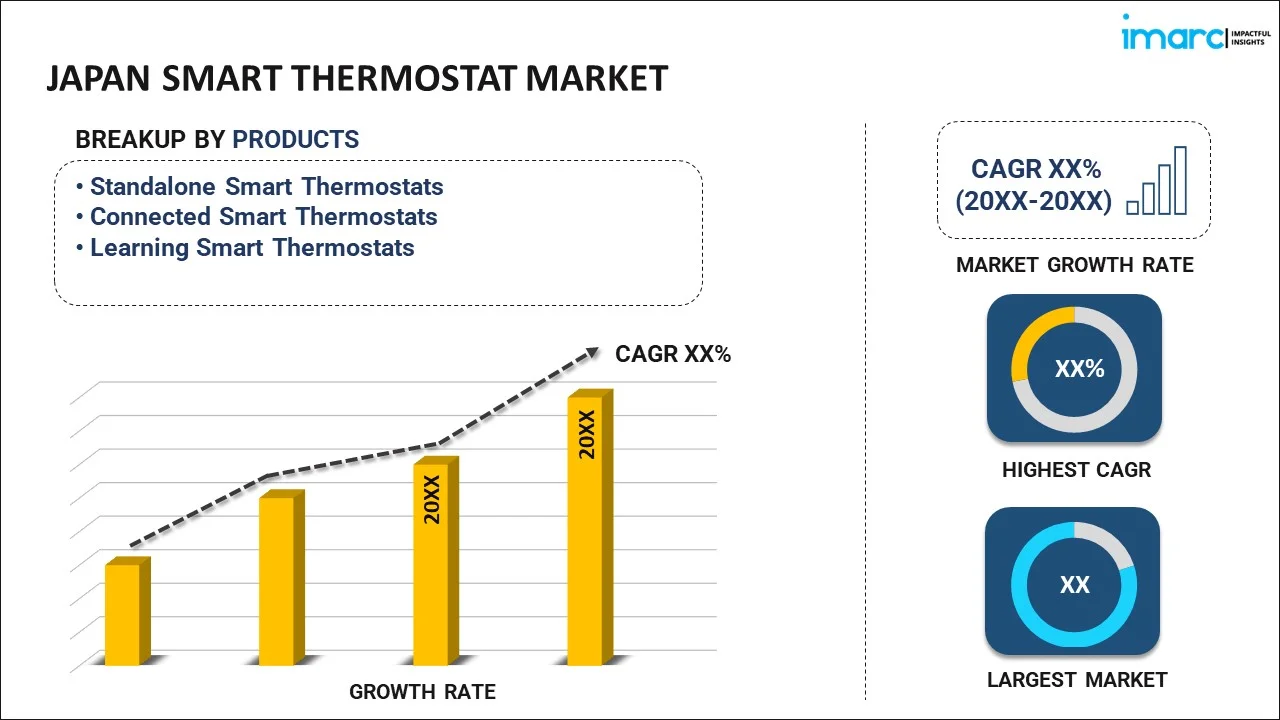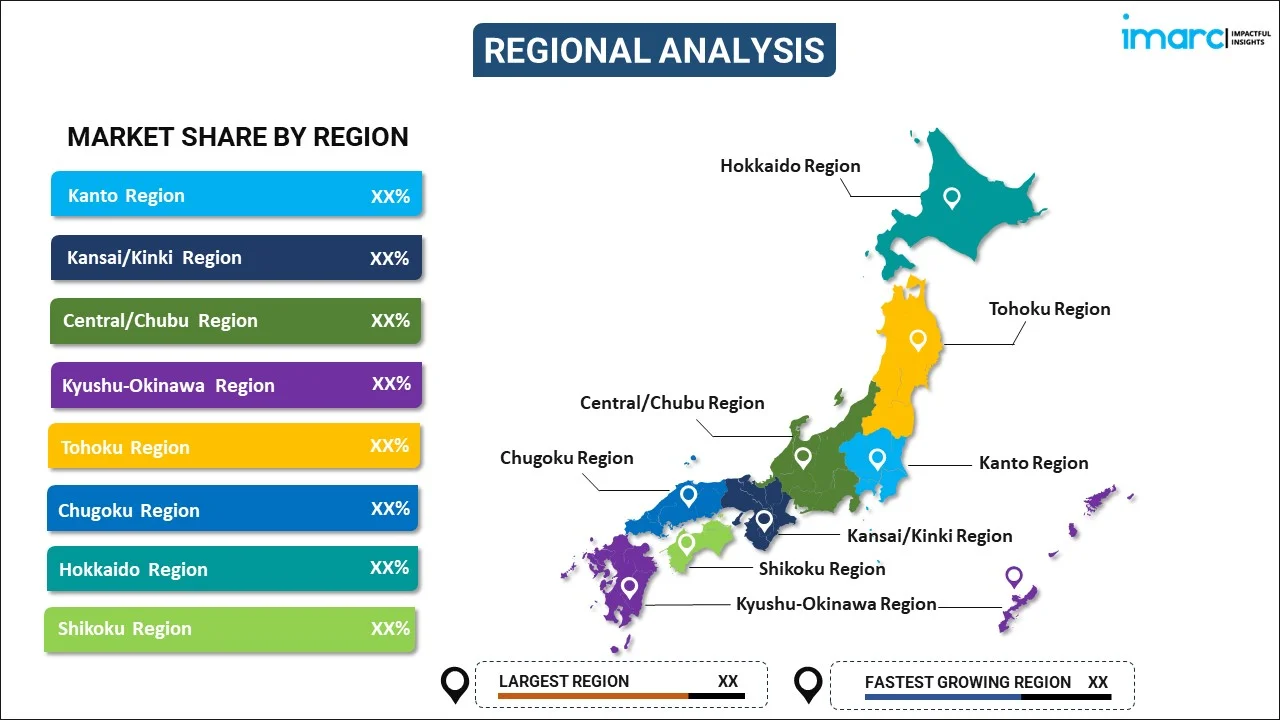
Japan Smart Thermostat Market Report by Product (Standalone Smart Thermostats, Connected Smart Thermostats, Learning Smart Thermostats), Component (Display, Temperature Sensors, Humidity Sensors, Motion Sensors, and Others), Technology (Wired, Wireless), Application (Residential, Commercial, Industrial), and Region 2025-2033
Market Overview:
Japan smart thermostat market size reached USD 184.8 Million in 2024. Looking forward, IMARC Group expects the market to reach USD 857.3 Million by 2033, exhibiting a growth rate (CAGR) of 17.2% during 2025-2033. The increasing awareness of energy efficiency and sustainability, the proliferation of the internet of things (IoT) and smart home technologies, government regulations promoting energy conservation, rising environmental consciousness, and technological advancements in artificial intelligence (AI) and machine learning (ML) are factors stimulating the market growth.
|
Report Attribute
|
Key Statistics
|
|---|---|
|
Base Year
|
2024
|
|
Forecast Years
|
2025-2033
|
|
Historical Years
|
2019-2024
|
| Market Size in 2024 | USD 184.8 Million |
| Market Forecast in 2033 | USD 857.3 Million |
| Market Growth Rate 2025-2033 | 17.2% |
A smart thermostat is a modern heating and cooling control device designed to enhance the efficiency and convenience of climate management within residential and commercial spaces. They utilize advanced technology to monitor and regulate indoor temperatures, offering a range of benefits to users. Smart thermostats are commonly used to optimize heating, ventilation, and air conditioning (HVAC) systems, allowing users to remotely adjust temperature settings through their smartphones or other connected devices. This capability provides homeowners with the flexibility to maintain comfortable indoor conditions while also reducing energy consumption and associated costs. One of the primary advantages of smart thermostats is their ability to learn user preferences over time, adapting to individual schedules and comfort preferences. Additionally, they provide detailed energy usage reports, empowering users with insights into their heating and cooling patterns, thus encouraging more efficient practices. Currently, there are several types of smart thermostats available in the market, such as programmable for user-set schedules and learning thermostats with artificial intelligence (AI), along with zoned and line voltage options.
Japan Smart Thermostat Market Trends:
The Japan smart thermostat market is influenced by several key drivers, such as the increasing emphasis on energy efficiency and sustainability, which has fueled the adoption of smart thermostats, as they enable users to optimize heating and cooling systems. Moreover, the rise in smart home automation and the Internet of Things (IoT) has propelled the market forward, as smart thermostats integrate seamlessly with other connected devices, thereby enhancing overall home automation experiences. Additionally, government regulations and initiatives promoting energy-efficient technologies have played a pivotal role in stimulating market growth, as they incentivize consumers and businesses to invest in smart thermostat solutions. This is further supported by the growing awareness of climate change and the need for eco-friendly solutions, which has led consumers to seek out environmentally conscious options. In line with this, advancements in technology, including machine learning and artificial intelligence, have enabled smart thermostats to learn user preferences and adapt heating and cooling patterns, which is accelerating the market growth. Other factors, such as the proliferation of smartphones, the increasing availability of affordable smart thermostat options, and the ease of installation, are fueling the market growth across the country.
Japan Smart Thermostat Market Segmentation:
IMARC Group provides an analysis of the key trends in each segment of the market, along with forecasts at the country level for 2025-2033. Our report has categorized the market based on product, component, technology, and application.
Product Insights:

- Standalone Smart Thermostats
- Connected Smart Thermostats
- Learning Smart Thermostats
The report has provided a detailed breakup and analysis of the market based on the product. This includes standalone smart thermostats, connected smart thermostats, and learning smart thermostats.
Component Insights:
- Display
- Temperature Sensors
- Humidity Sensors
- Motion Sensors
- Others
A detailed breakup and analysis of the market based on the component have also been provided in the report. This includes display, temperature sensors, humidity sensors, motion sensors, and others.
Technology Insights:
- Wired
- Wireless
- WiFi
- Zig Bee
- Others
The report has provided a detailed breakup and analysis of the market based on the Technology. This includes wired and wireless (WiFi, zig bee, and others).
Application Insights:
- Residential
- Commercial
- Industrial
A detailed breakup and analysis of the market based on the application have also been provided in the report. This includes residential, commercial, and industrial.
Regional Insights:

- Kanto Region
- Kansai/Kinki Region
- Central/ Chubu Region
- Kyushu-Okinawa Region
- Tohoku Region
- Chugoku Region
- Hokkaido Region
- Shikoku Region
The report has also provided a comprehensive analysis of all the major regional markets, which include Kanto Region, Kansai/Kinki Region, Central/ Chubu Region, Kyushu-Okinawa Region, Tohoku Region, Chugoku Region, Hokkaido Region, and Shikoku Region.
Competitive Landscape:
The market research report has also provided a comprehensive analysis of the competitive landscape. Competitive analysis such as market structure, key player positioning, top winning strategies, competitive dashboard, and company evaluation quadrant has been covered in the report. Also, detailed profiles of all major companies have been provided.
Japan Smart Thermostat Market Report Coverage:
| Report Features | Details |
|---|---|
| Base Year of the Analysis | 2024 |
| Historical Period | 2019-2024 |
| Forecast Period | 2025-2033 |
| Units | Million USD |
| Scope of the Report | Exploration of Historical Trends and Market Outlook, Industry Catalysts and Challenges, Segment-Wise Historical and Future Market Assessment:
|
| Products Covered | Standalone Smart Thermostats, Connected Smart Thermostats, Learning Smart Thermostats |
| Components Covered | Display, Temperature Sensors, Humidity Sensors, Motion Sensors, Others |
| Technologies Covered |
|
| Applications Covered | Residential, Commercial, Industrial |
| Regions Covered | Kanto Region, Kansai/Kinki Region, Central/ Chubu Region, Kyushu-Okinawa Region, Tohoku Region, Chugoku Region, Hokkaido Region, Shikoku Region |
| Customization Scope | 10% Free Customization |
| Post-Sale Analyst Support | 10-12 Weeks |
| Delivery Format | PDF and Excel through Email (We can also provide the editable version of the report in PPT/Word format on special request) |
Key Questions Answered in This Report:
- How has the Japan smart thermostat market performed so far and how will it perform in the coming years?
- What has been the impact of COVID-19 on the Japan smart thermostat market?
- What is the breakup of the Japan smart thermostat market on the basis of product?
- What is the breakup of the Japan smart thermostat market on the basis of component?
- What is the breakup of the Japan smart thermostat market on the basis of technology?
- What is the breakup of the Japan smart thermostat market on the basis of application?
- What are the various stages in the value chain of the Japan smart thermostat market?
- What are the key driving factors and challenges in the Japan smart thermostat?
- What is the structure of the Japan smart thermostat market and who are the key players?
- What is the degree of competition in the Japan smart thermostat market?
Key Benefits for Stakeholders:
- IMARC’s industry report offers a comprehensive quantitative analysis of various market segments, historical and current market trends, market forecasts, and dynamics of the Japan smart thermostat market from 2019-2033.
- The research report provides the latest information on the market drivers, challenges, and opportunities in the Japan smart thermostat market.
- Porter's five forces analysis assist stakeholders in assessing the impact of new entrants, competitive rivalry, supplier power, buyer power, and the threat of substitution. It helps stakeholders to analyze the level of competition within the Japan smart thermostat industry and its attractiveness.
- Competitive landscape allows stakeholders to understand their competitive environment and provides an insight into the current positions of key players in the market.
Need more help?
- Speak to our experienced analysts for insights on the current market scenarios.
- Include additional segments and countries to customize the report as per your requirement.
- Gain an unparalleled competitive advantage in your domain by understanding how to utilize the report and positively impacting your operations and revenue.
- For further assistance, please connect with our analysts.
 Request Customization
Request Customization
 Speak to an Analyst
Speak to an Analyst
 Request Brochure
Request Brochure
 Inquire Before Buying
Inquire Before Buying




.webp)




.webp)












